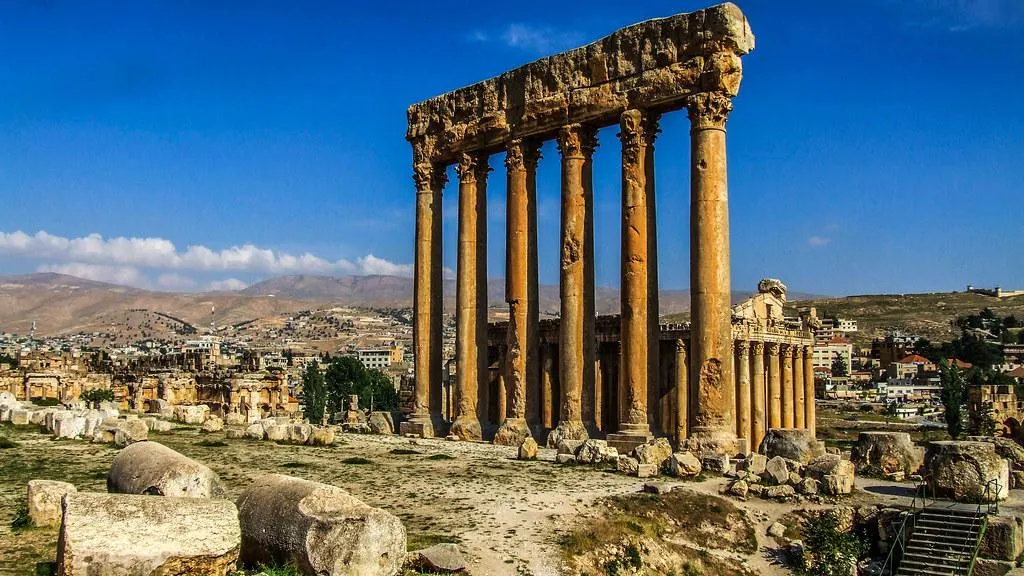Virtual Tour Restores Baalbek’s Stunning Roman Temples to Their Former Glory
The free online experience allows users to toggle between views of the ancient Lebanese city today and as it appeared in 215 A.D.
:focal(742x357:743x358)/https://tf-cmsv2-smithsonianmag-media.s3.amazonaws.com/filer/09/92/09929df3-c0e8-48f9-9c84-cfa502b877e6/the_virtual_reconstruction_of_the_altar_court_copyright_of_flyover_zone_productions_and_dai.png)
Due to Covid-19 restrictions, few visitors can currently travel to Baalbek, a city in Lebanon’s Bekaa Valley that houses some of the Roman Empire’s greatest temple ruins. Luckily, a new virtual tour allows people anywhere in the world to view the site both as it appears today and as it looked at its peak in 215 A.D.
As Maghie Ghali reports for the Abu Dhabi–based National, the Lebanese Directorate of General Antiquities and the German Archaeological Institute collaborated with virtual tour company Flyover Zone to create the online experience, titled Baalbek Reborn: Temples.
“No list of the world’s most important tourist destinations would be complete without Baalbek, so you can well understand why we jumped at the opportunity to recreate Baalbek in the Roman period,” Flyover Zone founder Bernard Frischer, who previously led a similar digital reconstruction of ancient Rome, tells the National.
Baalbek, a Unesco World Heritage Site, was a Phoenician city known during the Hellenistic period as Heliopolis. Under the Roman Empire, Baalbek reached its most impressive state, housing a complex of temples built over a period of more than 200 years. Pilgrims visited the city to worship the Romanized “triad” of Heliopolis: the deities Jupiter, Venus and Mercury.
The city’s most impressive building, the sanctuary of the Heliopolitan Jupiter, boasted 65-foot-tall columns placed atop 3,000-ton stone blocks, according to Elif Batuman of the New Yorker. Other places of worship at the site included the Round Temple, which was dedicated to Venus, and an intricately decorated temple honoring Bacchus. Today, notes Unesco, Baalbek’s Temple of Mercury is mostly destroyed.
Frischer says the site was home to one of the most important oracles of the ancient world. This Baalbek prophet was dedicated to Heliopolitan Jupiter.
“Emperors consulted it,” he tells the National. “Everyone wanted to know whether they should get married, take a trip or start a business, start a war, and they all asked the oracle.”
The free app—available for computer, mobile devices and virtual reality headsets—offers interactive, 360-degree views of 38 locations in the city, reports Robert McKelvey for Al Jazeera. Users can listen to expert audio commentary in Arabic, English, French or German and call up additional images and text for more information about specific spots. They can also toggle between seeing the buildings as they appear today and as they looked almost 2,000 years ago.

“The representation you can see will be tailored to the content of the commentary,” Henning Burwitz, a building historian and architect with the German Archaeological Institute, tells Al Jazeera. “If we explain the site today, you will see it as it looks today but if we talk about what it looked like in 215, the image will switch automatically to take you on a time travel to the year 215 and to show you what it looked like in antiquity.”
Humans have lived in the area now known as Baalbek since at least 9000 B.C. Under the Phoenicians, the city became a center for the worship of the sky-god Baal and the goddess Astarte.
Per Encyclopedia Britannica, Baalbek was controlled by Greece, Egypt and the Seleucid Empire before coming under Roman domain in the first century B.C. Between 1898 and 1903, a German expedition excavated the Roman temples. The French and Lebanese governments later cleared and repaired the site.
“There’s just something very special about the place,” Burwitz tells Al Jazeera. “It’s scientifically an extremely interesting place, being one of the more eastern Roman cities and sanctuaries. It’s quite a statement to build something like this in such a remote part of the Roman Empire.”
/https://tf-cmsv2-smithsonianmag-media.s3.amazonaws.com/accounts/headshot/Livia_lg_thumbnail.png)


/https://tf-cmsv2-smithsonianmag-media.s3.amazonaws.com/accounts/headshot/Livia_lg_thumbnail.png)